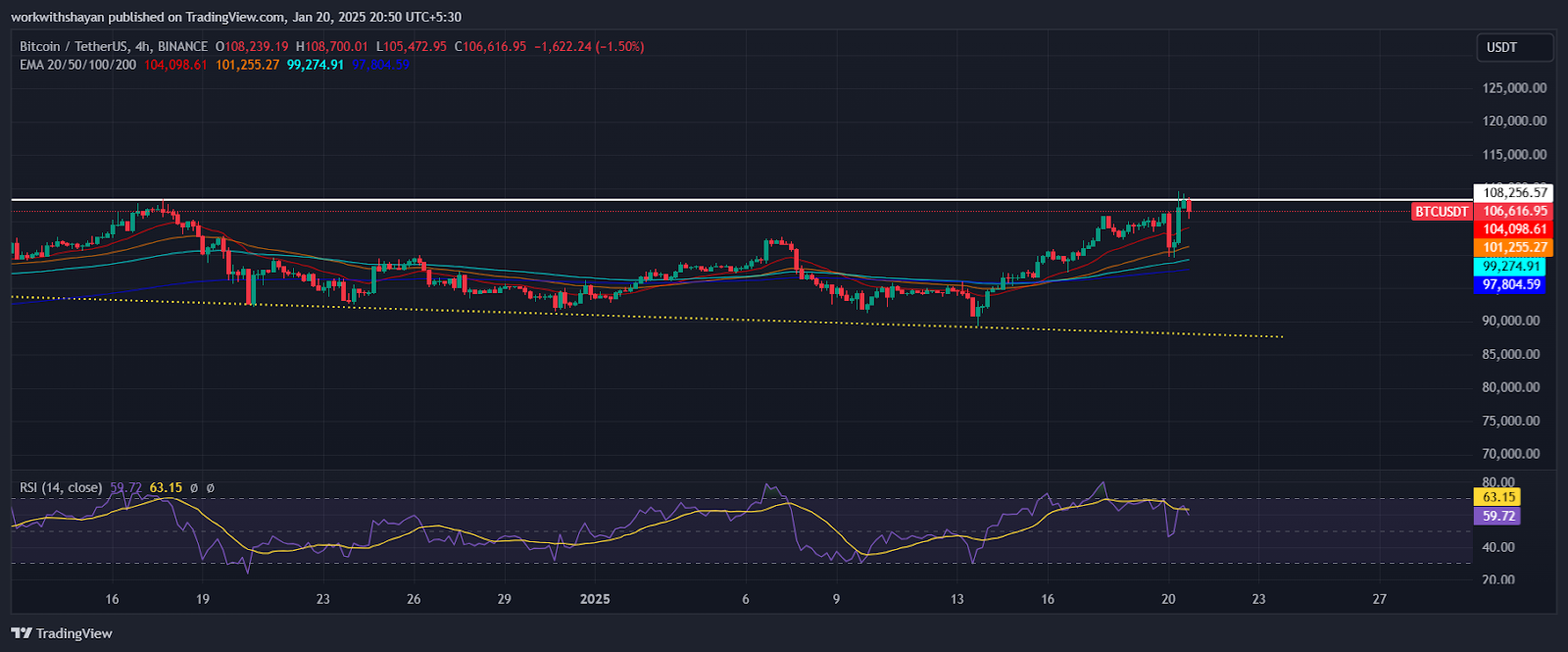
Although Bitcoin’s price recently surged toward $109,000, it couldn’t maintain its momentum and quickly fell to a low of $105,472. The trading volume for Bitcoin has increased by 101% over the past 24 hours, reaching $114.6 billion.
Looking at a broader time frame, Bitcoin dropped below $100,000 on January 7 and has generally been on a downward trend since then. It hit a low of about $89,397 on January 13 but has begun to recover from this decline. Over the last 24 hours, its total market capitalization has risen by 2.9% to $2.13 trillion.
Bitcoin’s Large Transaction Volume Declines
Several analysts have observed that when Bitcoin’s price rises, the likelihood of establishing a Bitcoin reserve also increases. It appears that a price increase in Bitcoin makes the setup of a reserve more probable.
This week, Bitcoin’s price increased by 18.4% and saw a gain of 10.4% over the past 30 days. Today, Bitcoin’s price touched a high of $109,588 but didn’t attract enough buyers, leading to an immediate drop toward $105,472.

Over the last 48 hours, the large transaction volume of Bitcoin has been declining. Data from IntoTheBlock shows that the metric dropped from the peak of 912K BTC to a low of 705K BTC. This decline suggests a decreased interest in trading activity among whales.
As whales take less interest in Bitcoin, this might create a correction on the price chart. Additionally, the rising US debt might be a bearish threat for Bitcoin price, which might create a wave of selling activity among holders if BTC struggles to surpass resistance levels.
However, the funding rate of Bitcoin remains positive despite the bearish threat. It is currently at 0.0271%, suggesting that buyers still have the advantage in bouncing back from the current level and breaking through $111K.
Bitcoin Price Prediction: Technical Analysis
Bitcoin price has been on a strong surge as it broke above previous resistance levels and is now attempting to attain a new ATH. However, it is experiencing some selling pressure around the $109K level, creating a significant challenge for buyers. Right now, Bitcoin is priced at $107,811, having risen by 2.7% in the last 24 hours.

The Bitcoin to USDT trading pair is still just under $109,000, which might pose a slight challenge. If it can stay above this level, it would be advantageous for buyers. The price could then rise to $111,000, and potentially even to $115,000.
On the other hand, if the price drops below the EMA20 trend line on the 1-hour chart, sellers might push it back down to $104K. However, RSI suggests there might be a potential rise, as it’s currently at a level (64) that indicates buying interest.
Bitcoin Price Prediction: What to Expect Next?
Short-term: According to BlockchainReporter, BTC price might continue to struggle around $109K. However, the pressure might soon weaken, resulting in a surge toward $111K.
Long-term: According to the Bitcoin price prediction from Coincodex, the price of Bitcoin is expected to increase by 22.23% and reach $131,946 by February 19, 2025. Coincodex’s technical indicators suggest that the current market sentiment is Bullish, and the Fear & Greed Index indicates a level of 76, which corresponds to Extreme Greed. Over the past 30 days, Bitcoin has experienced 15 out of 30 green days and a price volatility of 3.13%. Based on this forecast, it is currently considered a good time to buy Bitcoin.
How much is Bitcoin price today?
Bitcoin price is trading at $107,811 at the time of writing. The BTC price has increased by over 2.7 % in the last 24 hours.
What is the BTC price prediction for January 20?
Throughout the day, BTC price might continue to struggle around $109K. However, the pressure might soon weaken, resulting in a surge toward $111K.
Is Bitcoin a Good Buy Now?
According to long-term forecasts, Bitcoin price might reach $131,946 by February 19. This makes BTC price a good investment considering its monthly yield.
Investment Risks for Bitcoin
Investing in Bitcoin can be risky due to market volatility. Investors should:
- Conduct technical and on-chain analysis.
- Assess their financial situation and risk tolerance.
- Consult with financial advisors if necessary.









